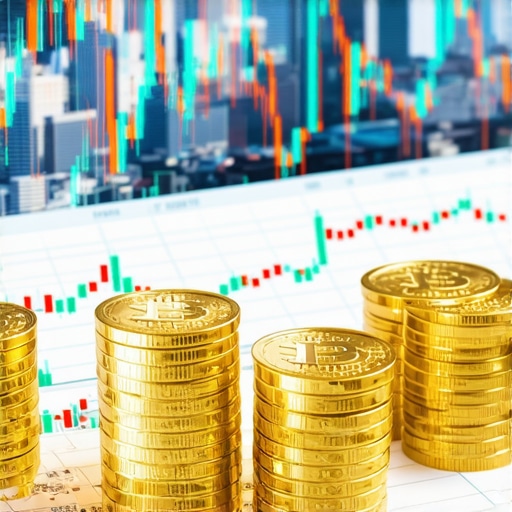Understanding Gold as a Safe Haven Asset
Gold has long been recognized as a safe haven asset, particularly in times of economic uncertainty and inflation. Investors often turn to gold during periods of rising prices, as it has the unique ability to retain its value over time. Unlike fiat currencies, which can be printed and devalued at will, gold is a finite resource that tends to appreciate when inflation rises. This characteristic makes gold an attractive option for those looking to protect their wealth against the erosive effects of inflation.
The Mechanics of Inflation and Gold
Inflation occurs when there is an increase in the prices of goods and services, diminishing the purchasing power of currency. As inflation rises, the value of cash holdings decreases, prompting investors to seek alternatives that preserve value. Gold serves as an effective hedge against inflation because it often moves inversely to the value of the dollar. When the dollar weakens, gold prices typically rise, allowing investors to maintain their purchasing power.
Historical Context: Gold During Inflationary Periods
Historically, gold has demonstrated a strong correlation with inflation. For example, during the high inflationary period of the 1970s, gold prices skyrocketed, providing significant returns for investors. This trend has led many to believe that gold can act as a reliable store of value during inflationary phases. Moreover, central banks around the world often increase their gold reserves as a strategy to mitigate the impact of inflation on their economies.
Current Economic Climate and Gold’s Role
In today’s economic environment, characterized by supply chain disruptions and unprecedented monetary policies, the relevance of gold as an inflation hedge has resurfaced. With central banks injecting substantial amounts of money into their economies, concerns about future inflation are growing. Investors are increasingly looking at gold not just as a luxury item but as a critical component of a diversified investment portfolio. As a result, understanding how to navigate gold investments can be vital for those looking to secure their financial future.
For more insights on how to effectively invest in gold and leverage its benefits during inflationary periods, consider exploring our comprehensive guides on investing in gold and adding gold to your investment portfolio. These resources will equip you with the knowledge needed to make informed decisions about your gold investments.
Investing in Gold: A Timely Strategy
Given the current economic landscape, many investors are recognizing the importance of diversifying their portfolios with gold as a hedge against inflation. Understanding the nuances of gold investments can empower you to make strategic decisions that align with your financial goals. Various forms of gold investments, such as gold coins, gold bullion, and gold ETFs, offer unique advantages that can cater to different investment strategies.
Diversifying with Gold: A Smart Move
Diversification is a key principle of investing, and incorporating gold into your portfolio can help mitigate risks during periods of economic instability. Gold’s historical performance shows that it often retains its value or appreciates when other assets, such as stocks or bonds, experience volatility. This characteristic makes gold a vital asset for investors looking to achieve a balanced portfolio. To explore the advantages of gold in diversification, check out our guide on adding gold to your investment portfolio.
Understanding the Different Types of Gold Investments
When it comes to investing in gold, there are several options to choose from. Each type of investment has its own benefits and risks.
Physical Gold vs. Paper Gold
Investors can choose between physical gold, such as coins and bars, and paper gold, which includes gold ETFs and mutual funds. Physical gold provides a tangible asset that can be stored and secured, while paper gold offers ease of trading and liquidity. Understanding the differences between these options is essential for making informed investment decisions. For insights on physical gold investments, refer to our article on best practices for buying physical gold bars.
Gold ETFs: A Convenient Option
Gold exchange-traded funds (ETFs) have become increasingly popular among investors. These funds allow you to invest in gold without the need for physical storage. They track the performance of gold prices and can be traded like stocks. This convenience makes gold ETFs an attractive option for those looking to gain exposure to gold while maintaining liquidity. For a deeper understanding of gold ETFs, explore our guide on gold ETFs for beginner investors.
Key Considerations for Gold Investments
Investing in gold requires careful consideration of various factors. Market conditions, interest rates, and global economic trends can all influence gold prices. Additionally, understanding how gold reacts to market changes can help you make timely investment decisions. To learn more about these dynamics, review our article on how gold prices react to market changes.
Conclusion: The Strategic Importance of Gold
In summary, gold remains a vital investment option for those looking to hedge against inflation and diversify their portfolios. By exploring the different types of gold investments and understanding the market factors that influence gold prices, you can position yourself for success in the ever-changing economic landscape. For more insights on investing in gold and maximizing your returns, consider visiting our comprehensive resources on analyzing gold price trends and gold price forecasts.
Strategies for Successful Gold Investments
To maximize your returns in the gold market, it’s essential to adopt effective investment strategies. Whether you’re investing in gold coins, bars, or ETFs, having a clear plan can significantly impact your investment success.
Understanding Market Trends and Timing
Keeping an eye on market trends is crucial when investing in gold. Factors like geopolitical events, economic indicators, and changes in interest rates can influence gold prices. By understanding these trends, you can make informed decisions about when to buy or sell your gold investments. For expert insights, refer to our analysis on key factors influencing gold price.
Diversification Within Gold Investments
While gold itself is a great diversifier, consider diversifying within your gold investments. This can include a mix of physical gold, gold stocks, and gold ETFs. Each category has its risk and return profile, and a balanced approach can help mitigate potential losses. For a deeper dive into gold stocks, explore how to evaluate gold stocks.
Staying Informed on Gold Demand Trends
The demand for gold can fluctuate based on various factors, including consumer demand, industrial use, and investment demand. Understanding these trends can help you anticipate price movements and adjust your strategy accordingly. Our post on gold demand trends offers valuable insights.
Leveraging Gold for Financial Security
Gold isn’t just an investment; it can also serve as a safeguard for your financial future. By incorporating gold into your investment portfolio, you can enhance your overall financial security.
Gold as a Hedge Against Inflation
One of gold’s most significant advantages is its ability to act as a hedge against inflation. In times of rising prices, gold tends to retain its value, making it a reliable store of wealth. To learn more about how gold can protect your investments during inflationary periods, read our article on gold as a hedge against inflation.
Gold’s Role in Economic Uncertainty
During times of economic uncertainty, investors often flock to gold, driving up its price. This characteristic makes gold a sought-after asset during market downturns. By understanding how to navigate these turbulent times, you can better position yourself to profit from gold investments. Explore our insights on understanding gold futures for more knowledge on gold trading strategies.
Conclusion: Embracing Gold in Your Investment Strategy
Investing in gold can offer significant benefits and opportunities for growth. By staying informed about market trends, diversifying your investments, and understanding gold’s role in economic fluctuations, you can enhance your investment strategy. For further guidance on maximizing your gold investments, check out our comprehensive resources on analyzing gold price trends and gold price forecasts.
Preparing for Future Gold Market Trends
As the gold market evolves, staying ahead of emerging trends is essential for any investor. With 2025 approaching, understanding potential shifts in the market can help you optimize your investment strategy.
Anticipating Economic Influences on Gold
Gold prices are highly sensitive to economic changes. Factors such as interest rate adjustments, inflation rates, and overall economic growth can influence investor behavior. For example, as interest rates rise, the opportunity cost of holding gold increases, which may lead to price declines. Conversely, during periods of low interest rates, gold often becomes more attractive. To navigate these changes, consider our insights on key factors influencing gold price.
Impact of Geopolitical Events on Gold Investment
Geopolitical tensions often drive gold prices higher as investors seek safe havens. Events such as conflicts, trade wars, and political instability can lead to increased demand for gold. By keeping abreast of these developments, you can better time your investments. Explore our article on the role of central banks in gold price fluctuations for a deeper understanding of how global politics affect gold.
Maximizing Returns through Smart Gold Investment Techniques
To achieve optimal returns, employing effective strategies is key. Here are some techniques to consider for your gold investment portfolio.
Utilizing Gold ETFs for Flexibility
Gold Exchange Traded Funds (ETFs) provide a flexible way to invest in gold without the need for physical storage. These funds can track the price of gold and offer liquidity, making them an attractive option for investors. If you’re new to ETFs, our guide on how to invest in gold ETFs can provide you with essential insights.
Engaging in Gold Futures for Strategic Investments
Gold futures can be an advanced investment strategy for those looking to leverage their positions. By agreeing to buy or sell gold at a predetermined price in the future, you can capitalize on market fluctuations. However, this strategy requires careful planning and risk management. For beginners, our article on understanding gold futures offers valuable information to get started.
Evaluating Performance and Adjusting Your Strategy
Continuous evaluation of your investment performance is crucial. Regularly reviewing your portfolio allows you to make necessary adjustments based on market conditions and personal financial goals.
Monitoring Gold Price Trends
By analyzing historical gold price trends and forecasting future movements, you can make informed decisions. Use our resource on analyzing gold price trends to help guide your investment choices.
Adjusting Your Portfolio Based on Market Conditions
Market conditions can change rapidly, and your investment strategy should be adaptable. Whether it’s reallocating assets between physical gold and gold stocks or adjusting your ETF holdings, being proactive can enhance your returns. For strategic insights, check out our post on top gold investment strategies.
Understanding Gold Investment Strategies
Gold has always been a significant part of investment portfolios, particularly in times of economic uncertainty. With the world evolving, especially as we approach 2025, it’s crucial to align your gold investment strategies with emerging trends and market dynamics. This guide aims to equip you with the knowledge and tools necessary to navigate the gold market effectively.
Comprehensive FAQ on Gold Investment
What are the main benefits of investing in gold?
Investing in gold provides a hedge against inflation, currency fluctuations, and geopolitical instability. Gold often retains its value over time, making it a reliable asset for wealth preservation.
How does gold perform during economic downturns?
During economic downturns, gold typically appreciates in value as it is viewed as a safe-haven asset. Investors flock to gold when traditional investments like stocks decline, driving up demand and prices.
What types of gold investments are available?
Investors can choose from various gold investment options, including physical gold (bars and coins), gold ETFs, gold mining stocks, and gold futures contracts. Each option has its risk and return profiles.
Is it better to invest in physical gold or ETFs?
This depends on your investment goals. Physical gold offers direct ownership and is tangible, while ETFs provide liquidity and ease of trading without the need for storage. Evaluate your preferences and risk tolerance to make the best choice.
How do geopolitical events affect gold prices?
Geopolitical events can lead to increased uncertainty, prompting investors to seek safe-haven assets like gold. Conflicts, trade disputes, and political instability can drive gold prices higher due to increased demand.
What is the best time to invest in gold?
While timing the market can be challenging, many investors prefer to buy gold during periods of low prices or economic uncertainty. Continuous monitoring of market trends and price fluctuations can help you identify potential buying opportunities.
How should I store physical gold?
Physical gold should be stored securely, either in a safe at home or in a safety deposit box at a bank. Consider using dedicated vault services that specialize in precious metals storage for added security.
Can gold mining stocks be a good investment?
Gold mining stocks can offer leveraged exposure to gold prices, meaning they often rise more than gold itself during price increases. However, they also carry additional risks associated with mining operations, management decisions, and market fluctuations.
What are the risks of investing in gold?
While gold is considered a safe-haven asset, it is not without risks. Price volatility, storage costs for physical gold, and the performance of mining companies can all impact your investment returns. It’s essential to diversify your portfolio to mitigate these risks.
How can I stay updated on gold market trends?
Follow reputable financial news sources, subscribe to gold market newsletters, and utilize financial analysts’ insights to stay informed. Regularly checking market reports and economic indicators can also help you make informed investment decisions.
Authority Resources for Gold Investment
For those looking to deepen their understanding of gold investments, the following resources are invaluable:
- Investopedia – Gold Investment
- The Economist – Gold Articles
- World Gold Council
- Kitco – Precious Metals
- BullionVault
Conclusion
Investing in gold remains a strategic move for many investors, especially as we look towards 2025 and beyond. By understanding the various investment strategies, monitoring market trends, and utilizing resources from authoritative sources, you can make informed decisions. Whether you prefer physical gold, ETFs, or mining stocks, adapting your approach to the ever-changing market landscape is key to maximizing your returns. Embrace the potential of gold investment and secure your financial future today.










